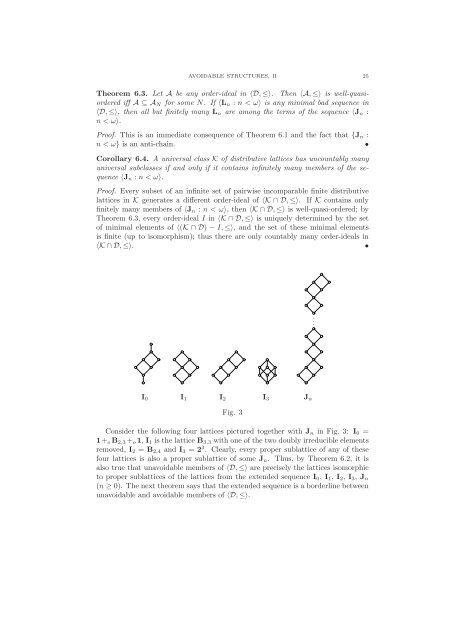Avoidable structures, II: finite distributive lattices and nicely ...
Avoidable structures, II: finite distributive lattices and nicely ...
Avoidable structures, II: finite distributive lattices and nicely ...
You also want an ePaper? Increase the reach of your titles
YUMPU automatically turns print PDFs into web optimized ePapers that Google loves.
AVOIDABLE STRUCTURES, <strong>II</strong> 25<br />
Theorem 6.3. Let A be any order-ideal in 〈D,≤〉. Then 〈A,≤〉 is well-quasiordered<br />
iff A ⊆ A N for some N. If 〈L n : n < ω〉 is any minimal bad sequence in<br />
〈D,≤〉, then all but <strong>finite</strong>ly many L n are among the terms of the sequence 〈J n :<br />
n < ω〉.<br />
Proof. This is an immediate consequence of Theorem 6.1 <strong>and</strong> the fact that {J n :<br />
n < ω} is an anti-chain.<br />
•<br />
Corollary 6.4. A universal class K of <strong>distributive</strong> <strong>lattices</strong> has uncountably many<br />
universal subclasses if <strong>and</strong> only if it contains in<strong>finite</strong>ly many members of the sequence<br />
〈J n : n < ω〉.<br />
Proof. Every subset of an in<strong>finite</strong> set of pairwise incomparable <strong>finite</strong> <strong>distributive</strong><br />
<strong>lattices</strong> in K generates a different order-ideal of 〈K ∩ D,≤〉. If K contains only<br />
<strong>finite</strong>ly many members of 〈J n : n < ω〉, then 〈K ∩ D,≤〉 is well-quasi-ordered; by<br />
Theorem 6.3, every order-ideal I in 〈K ∩ D,≤〉 is uniquely determined by the set<br />
of minimal elements of 〈(K ∩ D) − I,≤〉, <strong>and</strong> the set of these minimal elements<br />
is <strong>finite</strong> (up to isomorphism); thus there are only countably many order-ideals in<br />
〈K∩D,≤〉.<br />
•<br />
I 0 I 1 I 2 I 3 J n<br />
Fig. 3<br />
Consider the following four <strong>lattices</strong> pictured together with J n in Fig. 3: I 0 =<br />
1+ o B 2,3 + o 1, I 1 is the lattice B 3,3 with one of the two doubly irreducible elements<br />
removed, I 2 = B 2,4 <strong>and</strong> I 3 = 2 3 . Clearly, every proper sublattice of any of these<br />
four <strong>lattices</strong> is also a proper sublattice of some J n . Thus, by Theorem 6.2, it is<br />
also true that unavoidable members of 〈D,≤〉 are precisely the <strong>lattices</strong> isomorphic<br />
to proper sub<strong>lattices</strong> of the <strong>lattices</strong> from the extended sequence I 0 , I 1 , I 2 , I 3 , J n<br />
(n ≥ 0). The next theorem says that the extended sequence is a borderline between<br />
unavoidable <strong>and</strong> avoidable members of 〈D,≤〉.
















